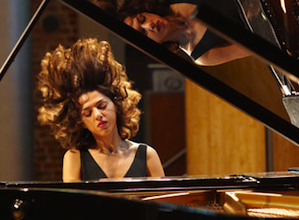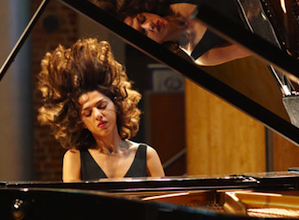
Georgian pianist Khatia Buniatishvili seems to have it all: accolades from the pantheon of great pianists, an extensive performance résumé, and a demanding schedule of over 100 concerts a year throughout Europe and in the U.S. Combined with her lightning fingers, powerful youthful exuberance, and glamor worthy of Hollywood, all at the tender age of 25, she is undoubtedly the envy of many aspiring pianists. With her very well received recent appearances with the San Francisco Symphony, I was thrilled to have an opportunity to hear her at a solo recital at the Napa Valley Opera House on March 2 to witness a bright star in the making. Yet this recital showed many artistic flaws as well as spellbinding moments and promise for the future.
Buniatishvili opened with a restrained rendition of Chopin Sonata No.2 in B-flat Minor. Perhaps due to the dry acoustics, the first theme did not quite attain the driving passion that I sought. Yet it was more than compensated by the seductive lyricism of the second theme, teasing the audience with playful counter-melodies. The volatile Scherzo was carried aggressively, with ferocious velocity that pushed the envelope.
However, Buniatishvilli gave a harrowingly imaginative reading of the funeral march with leaden footsteps of the bereaved depicted by the ostinato of the left hand. The warmer middle section was a continuous diminuendo to near silence, as if the soul of the deceased were vaporizing into the air. The audience almost seemed to have stopped breathing, too, trying to capture to the faintest trace of life as it disappeared. She was a master of pulling in the audience ever so gently with a single thread of the finest silk, but never letting go. She was a master of pulling in the audience ever so gently with a single thread of the finest silk, but never letting go.
The reading of Ravel’s macabre La Valse contrasted sharply with the Sonata and the wistfully sentimental yet well-structured reading of the Chopin Ballade No.4 that followed the Sonata. As the opulence and grandeur of the candle-lit mid-19th century Viennese scene grew, so did the tempo and intensity, becoming suffocating and relentless even in the relaxed middle section where the piece takes a breath before the catastrophic end. The ever-increasing velocity was incessant and the dance became unhinged long before the coda. There was no longer oxygen in the air, and the notes, along with the movement, colors, and textures drowned altogether toward the end, as if it were approaching the speed of light, pulled by the powerful gravity of a black hole.
The entropy increased even further to an impossible level in Stravinsky’s Petrushka — the most rushed performance of the piece I’ve ever encountered, whether as orchestral work or piano transcription. As if the goal were to tear through the three movements as rapidly as possible, the story and dances, so vivid in the ballet, were lost in the torrent of notes, wherever they may fall, as were two measures in Danse Russe, and as many as two pages of the “Dance of the Gypsy Girls” in The Shrovetide Fair. While the uncontrolled chain-reaction of fissile materials dazzled some with its searing, radiant energy, others in the audience appeared stunned by the devastation that the explosion left behind.
It seemed at times that Buniatishvili was disengaged from the recital entirely, as she started performing before the appreciative applause ended with every piece in the program, shying away from the vulnerability that solo recitals present. Burnout may be a possibility, too, given her impossibly dense, international performance schedule. However, there were many moments of exquisite beauty, tremendous intellect, and generous ardor which touched me warmly throughout the evening. With time and maturity, there is no doubt that she is capable of securing a place in the pantheon.

